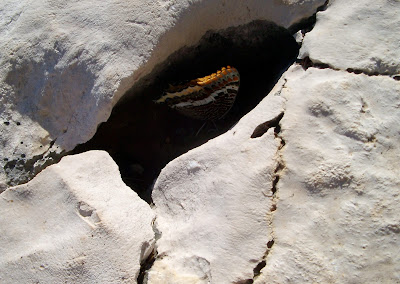Here's an exciting game of Spot the Moth for what is probably going to be my final post for 2024, though - who knows - a quiet and not-too-cold spell before the New Year may persuade me to plug in one last time. Anyway, the solitary resident of the eggboxes two nights ago was an attractive and good-condition Angle Shades. Can you spot it, above? Hours of fun, or half a minute at least.
Saturday 23 December 2023
Merry Christmas from - and to - the Moths
Sunday 19 November 2023
Autumn colours
Two Feathered Thorns came last night and you could be forgiven for thinking on first glance that they might be different species of moth. The yellowy, softly-shadowed one above is unlike any other I have had in the trap before. The one below is the usual form.
Both are males with their excellent antennae. Their solitary companion in the trap was a dozy Sprawler - like the Feathered Thorns, the possessor of a nice warm, furry collar on its thorax.
Wednesday 8 November 2023
Whiskery gents
Sunday 5 November 2023
Previous Pasha
As an epilogue to my last post, I thought that I should show you a photo of the only other time that I have seen a Two-tailed Pasha, on the serpentine island of Meneghello near Hvar in Croatia some 20 years ago. Unlike the hill-topper in Provence, it was swooping about on a beach and took cover in a fissure in the rocks - there is scarcely any sand in that part of the world. I managed to get the photo above but then it was off, and it did not come back.
Monday 30 October 2023
This year's treat
 A final pleasure of the holiday was the little Musée des Papillons in St Tropez whose incredibly good-value admission charge of only two Euros admitted you to a lovely little townhouse whose former owner collected butterflies from all over the world and then used them to supplement paintings of his native Provence. Reached by following butterflies inlaid in the pavement of an alley, it also had some terrific pictures of butterfly collectors in the old days. Merci beaucoup!
A final pleasure of the holiday was the little Musée des Papillons in St Tropez whose incredibly good-value admission charge of only two Euros admitted you to a lovely little townhouse whose former owner collected butterflies from all over the world and then used them to supplement paintings of his native Provence. Reached by following butterflies inlaid in the pavement of an alley, it also had some terrific pictures of butterfly collectors in the old days. Merci beaucoup!Wednesday 11 October 2023
Big time
I am a sucker for larger moths and it was a treat to find one in the trap this morning, a battered but still energetic Red Underwing. This moth has a history with Penny and myself going back years; on one memorable occasion she spotted one snoozing by the Thames under a pub umbrella whose colouring exactly matched the moth’s.
Today’s had a modestly exciting future in store as we were due to visit friends near Maidenhead and I wanted to take them an interesting moth. I therefore handled this one with extra caution, only waking it - partly to check in case it was a Clifden Nonpareil - when it was in the granddaughter’s specimen jar.
On arrival at our friends, it posed contentedly for a while and then headed off powerfully towards their roof, its flying unaffected by the battering which life has given its wings. Perhaps it will start a local family but I fear that it may be a little on the elderly side. Anyway, let’s hope that it enjoys Oxfordshire.
The trap has not been short of interest so far as more ordinarily-sized moths are concerned; last night’s guests included this nice Large Wainscot, above. The stylish Angle Shades below is enjoying a boom with six in the egg boxes and two variants of the Common Marbled Carpet obligingly posed so that you can see the difference.
Other pleasures include the strongly marked Willow Beauty, a Cypress Carpet with its sharply defined lines, a Satellite whose wing marks so closely resemble one of the sets of invading aliens in Space Invaders and a little Acleris kochiella micro.
Finally Penny noticed this unusual concentration of slug or snail slime on the patio and found two small mushrooms, apparently nibbled. But no slugs or snails. Perhaps they were poisoned and slithered off to expire.




















































